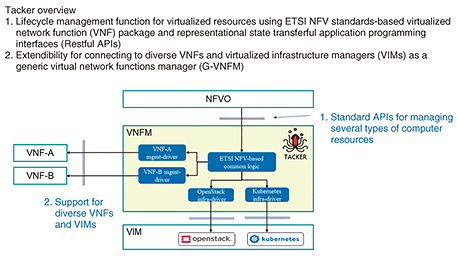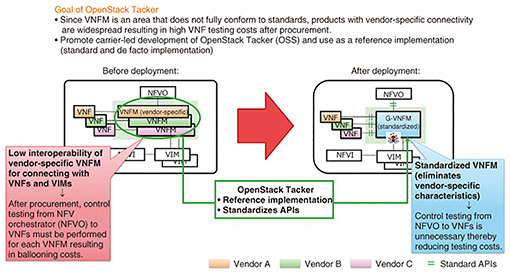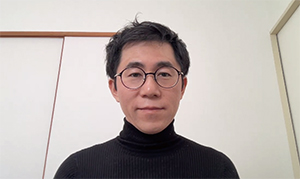 |
|
|
|
|
|
Rising Researchers Vol. 21, No. 5, pp. 12–16, May 2023. https://doi.org/10.53829/ntr202305ri1  Network Virtualization Technology for an NFV Infrastructure to Drive Innovation in the NetworkAbstractAs network services become increasingly diversified, the difficulty of predicting and dealing with spikes and fluctuations in data communications traffic is becoming apparent. However, studies are now underway at many telecom operators on ways of solving this problem by applying network virtualization technology for a network functions virtualization (NFV) infrastructure (software virtualization) to network services. In this article, we talked with Distinguished Researcher Yasufumi Ogawa about network virtualization technology for an NFV infrastructure. Keywords: virtualization, NFV infrastructure, open source community Achieving a low-cost, high-performance network through the virtualization of network software—Mr. Ogawa, please explain to us the meaning of network virtualization technology for a network functions virtualization (NFV) infrastructure. Before I talk about network virtualization technology for an NFV infrastructure, I would first like to explain “virtualization infrastructure.” Virtualization infrastructure refers to an infrastructure system and technology that can flexibly allocate the computer resources needed to meet a variety of requirements by using virtualization technology. For example, a high-performance machine would be necessary to run artificial intelligence or deep learning programs that have attracted much attention in recent years. For an individual, this would require that the parts and components making up the machine be procured, arranged, and assembled on one’s own. However, this process can be simplified by using a virtual machine. In other words, a virtual machine enables an individual to freely use a high-performance machine by tuning and occupying a portion of a huge actual machine in a datacenter for one’s own purposes. At this time, a variety of requirements may come into play such as robust security functions and high network performance, but a machine that instantly meets these requirements can be virtually prepared by simple operations such as mouse clicks and menu selection. This is a technical overview of virtualization infrastructure. Network virtualization technology for an NFV infrastructure focuses more attention on network functions. It can be called, in general, NFV. In this regard, the core functions of a large-scale network have extremely strict requirements in terms of quality and performance, but with conventional technology, these could only be met by using expensive dedicated equipment. On the other hand, network virtualization technology for an NFV infrastructure enables such expensive dedicated equipment to be replaced with general-purpose servers and software, which enables, in turn, the construction of a large-scale network in a simple and low-cost manner. Specifically, implementing software that performs the functions of dedicated equipment in existing general-purpose servers makes it possible to construct the equivalent of such dedicated equipment without any physical construction work. This approach offers great advantages for network operators who are concerned with reducing network development costs and shortening development periods. —What are you doing to achieve network virtualization technology for an NFV infrastructure? Although elemental technologies such as design techniques for virtual machines themselves and the concepts behind virtual networks have already been established, the current state of affairs is that there are many software development projects in progress. And while implementations are actively moving forward in the open source community and elsewhere, there is still much to be done in meeting requirements such as quality and availability to achieve practical networks. For this reason, NFV standards specified by the European Telecommunications Standards Institute (ETSI), a standardization organization centered in Europe whose members include telecom operators in many countries, are being implemented and provided in software called OpenStack Tacker as an initiative for creating new value (Fig. 1).
Tacker is one of the major OpenStack projects that aims to achieve NFV through virtualization infrastructure software. By replacing this with a version fully compliant with ETSI NFV standards, our goal is to be the first in the world to construct a practical and high-quality network infrastructure system. Although the standardization of NFV was already in motion when I began my research, the standards themselves have been evolving to keep up with an industry and requirements that change from year to year. At ETSI, there is a specific update plan for NFV standards, and at present, standards first drafted in Phase 1 have reached Phase 4. In terms of specific activities, I am currently serving as a Project Team Leader (PTL) in the OpenStack Tacker project, and in addition to providing source code that I write myself, I coordinate decisions on project development policy and take part in Tacker promotional activities. My duties, however, go beyond simply ensuring conformance to ETSI NFV standards targeted by Tacker—I am also involved in providing feedback on problems discovered during development. Furthermore, in addition to making contributions as a developer, I contribute to the expansion of network virtualization technology itself from the standpoint of practical development by interacting with a diverse range of players such as telecom operators and vendors both inside and outside Japan. —What difficulties come up in the research of network virtualization technology for an NFV infrastructure? In OpenStack, each project conducts development work independently, and as part of that work, a PTL has discretionary powers such as deciding development policy, formulating rules, and recommending candidates for becoming core members. Moreover, as a project representative, I am also involved in the overall administration of OpenStack. There is a lot of hard work that comes with these activities. For example, I coordinate the extraction of requirements and feedback related to requests for improvements for input to ETSI members, and in the case of a function that NTT would like to include as a requirement, I must make the rounds in obtaining approval from each member. As a specific activity to this end, I promote members that will have a significant say at meetings (core members) from within NTT and among corporate partners with which we closely exchange opinions. I am also involved in providing patches to source code, contributing reviews on improving the quality of patches from developers, sharing knowledge through presentations at international conferences such as OpenInfra Summit, and coordinating activities at OpenStack developer meetings (Project Teams Gathering). It is through efforts like these that I would like to disseminate a variety of technologies in society. Moreover, at the stage of technology implementation, interconnectivity, etc., any problems that occur must be immediately dealt with. The development of large-scale software like OpenStack makes use of a technique called continuous integration/continuous delivery (CI/CD) as a form of quality management to guarantee the operation of the product itself. Many steps in this technique from source code testing to operation checking are automated. Nevertheless, in actual development, there is a greater than 90% probability that some problems will occur such as design defects in the tests themselves or compatibility issues in libraries due to long-term development. Of course, dealing with these problems may seem like a straightforward issue, but to maintain this sense of normalcy, they must be understood with a broad range of knowledge about software design in existing code. Additionally, when a problem arises, its cause must be analyzed and corrected promptly, so we make a continuous effort to maintain advanced software development skills. Today, as well, new implementations are being incorporated in OpenStack one after another, and keeping up with such a massive code base and guaranteeing its quality is a painstaking effort. On the other hand, I feel that taking on such a challenging task is very rewarding. Our goal is to provide services that meet the needs of network operators—What kind of world can be achieved through network virtualization technology for an NFV infrastructure? As network services continue to diversify, network operators are finding it increasingly difficult to predict and respond to spikes and fluctuations in data communications traffic. As a result, we are entering a situation in which ensuring the reliability of communications as a social infrastructure at the time of a large-scale disaster or other calamity is difficult. There is a particular need to deal quickly with such problems in the mobile network in which the smartphone has become an essential part of daily life. Similarly, in the so-called fixed network that has been supporting telephone services up to now, the conventional way of thinking has been to increase earnings through long-term use of dedicated equipment developed at high cost. At present, however, this model no longer holds due to shortening of the development period and the time to provision as well as shortening of the service lifecycle. Against this background, I believe that we can fundamentally solve a variety of problems and be of great assistance to many network operators by applying network virtualization technology for an NFV infrastructure to these network services to enable speedy and flexible service provision that keeps implementation and maintenance costs down. In addition, providing a virtualization infrastructure system conforming to ETSI NFV standards has the advantage of ensuring interoperability with a variety of products. Today, large-scale systems are flooded with products having vendor-specific connectivity in which virtualized network function (VNF) testing costs and periods have ballooned and become a problem. Our goal, therefore, is to reduce testing costs on a scale of several billion yen by performing standardized implementation of virtualization infrastructure technology via Tacker to guarantee interoperability and eliminate vendor-specific characteristics (Fig. 2). Furthermore, the Innovative Optical and Wireless Network (IOWN) vision proposed by NTT includes an initiative to develop new server infrastructure technology that can both satisfy service requests and reduce power consumption by combining diverse types of devices as a disaggregated computing platform. In terms of software technology in such a lower-layer region, I believe that Tacker can be used to control computing resources on the controlled side and virtual resources installed as software in particular. In this regard, we are endeavoring in our research to achieve a world in which network virtualization technology for an NFV infrastructure can be provided as an infrastructure service incorporating a security and data-centric platform integral to IOWN in lower-layer software.
—What are some important ways of thinking in research and development (R&D)? As a researcher, I place value on what personally drives me and gives me satisfaction. In software development that I am involved in, a development team has a deadline to meet for each project, and to improve quality while satisfying as many requirements as possible within such an environment, I am sometimes forced as a project leader to pick and choose. At NTT laboratories, I am thoroughly involved in software development and I consider software to be a product of “distress” and “compromise.” In short, it is not simply a matter of selecting a path to “compromise.” What I want to do is to make the results of our efforts even more useful by placing importance on the “distress” involved in searching for a method that can be achieved in some way. In this way, I believe we can provide services that will please many people and that will provide a sense of accomplishment in R&D not just for me but for all team members as well. I also place importance on doing work that can be passed on to the next generation. For example, the work that I am doing has the possibility of being passed on to someone else in the future, so in my daily R&D work, I must keep in mind the process of continuously revising and upgrading software design while writing program source code in an orderly and clear manner. By so doing, I am not just creating something that will run well as a function. Rather, I am accumulating many things that anyone can understand just by reading and that can be easily taken over. This is not only for the present—my aim here is to pass the baton on to future R&D.
—Mr. Ogawa, can you leave us with a message for researchers, students, and business partners? The NTT Network Innovation Center that I belong to is a newly established organization based on the IOWN vision. Its origin can be found in the extensive history of NTT’s R&D on telecommunications technologies over many decades, and in my mind, it’s an organization that aims to consolidate those achievements toward an even greater goal. I feel that it covers a wide range of research fields from the core network to the access network and that it employs a large number of professionals especially in the practical implementation phase. For example, in network server software, the field that I specialize in, we are involved in the development of various types of applications used by NTT operating companies while having other duties too at standardization bodies and open software communities. I believe that the great strength of R&D at NTT is the many professionals in each field, the use of diverse connections including NTT Group companies, and an environment in which ideas and opinions can be easily exchanged. In addition, NTT has much influence not only within the NTT Group but also with other companies and communities both in Japan and overseas. There are many people that have listened positively to our proposals and become good allies, so for researchers who would like to be globally active, I think that NTT laboratories can be a very attractive place to work. Our work in the development of network infrastructure technology using open source software (OSS) is very practical in nature within the practical development phase of R&D. Additionally, since we engage in daily discussions on future network technology and become involved with a variety of companies and organizations, we feel that our efforts are extremely worthwhile having a great impact on society. International conferences such as OpenInfra Summit, moreover, give us the opportunity to play an active role at gatherings of prominent researchers from around the world. In addition, standardization organizations and other open source communities can have a great impact on the world since they enable many companies to come together to create standards, specifications, and de facto products in a cooperative manner. To those individuals who would like to take part in such a global community as a software developer or who have an interest in large-scale themes such as creating the network infrastructure of the future, I sincerely hope that you will join us in our activities. ■Interviewee profileYasufumi Ogawa graduated from the Graduate School of Engineering, Osaka University in 2003 and joined NTT the same year. He has belonged to NTT Network Innovation Center since 2021 and has been a distinguished researcher at NTT Network Innovation Center since 2022. He is engaged in the research and development of network virtualization technology for an NFV infrastructure. He has spoken at many international conferences including OpenInfra Summit 2020 and DPDK Summit 2019. He serves as a project leader in the OpenStack community. |



